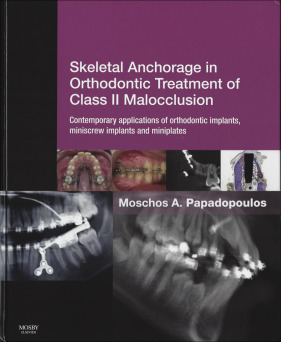
Over the past decade, orthodontic skeletal anchorage devices have gained significant traction in the orthodontic community. These devices have become instrumental in vertical control of the dentition, anteroposterior movement of the dentition, and in particular, molar distalization for the treatment of Class II malocclusion. The collaborative efforts of numerous clinicians are pooled in this new textbook on the treatment of Class II malocclusions with skeletal anchorage, especially with miniscrew implants and miniplates.
This well-organized book begins with a brief review of Class II malocclusions and their treatments using conventional noncompliance appliances and quickly transitions to an extensive review of temporary anchorage devices, covering the range of traditional implants, onplants, miniplates, and miniscrew implants. Because of the abundance of brands in the marketplace, particular attention is given to miniscrew implants, with a detailed analysis of their composition and mechanical structure. This left this reviewer amazed at the progress with miniscrew implants since our first publication on the topic. The detailed and particular attention given to the insertion site and the insertion technique makes this a must-read book for every orthodontic resident and novice user of temporary anchorage devices because various fabrication techniques for surgical guides are discussed to assist clinicians in avoiding common placement complications.
The text is peppered with abundant, high-quality photographs that aid the reader in developing a thorough understanding of the treatment mechanics used in the presented cases. An extensive review of molar distalization is presented, using both direct and indirect anchorage techniques with onplants, zygomatic anchorage, and palatal and interdental miniscrew implant anchorage. Although high-quality treatment results are presented with many unique treatment techniques and treatment mechanics, some presented cases had complicated and at times inefficient treatment techniques that may be best suited for educational institutions, rather than the moderate to large private practices that are often found in North America.
The book concludes with a review of risk factors, complications including root and bone responses, inadvertent root contact during placement, maxillary sinus perforation, and risk-management must-knows for practitioners placing miniscrew implants. Overall, the book is a valuable resource and reference for any orthodontist, periodontist, and maxillofacial surgeon who places miniscrew implants and miniplates as anchorage aids during orthodontic treatment.
Stay updated, free dental videos. Join our Telegram channel

VIDEdental - Online dental courses


